A Ramble in Harrold in 1879
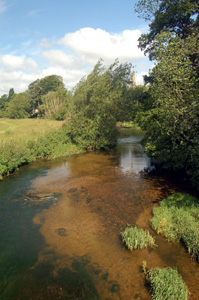
The River Great Ouse looking upstream June 2008
The following article, part of a series of rambles around various Bedfordshire parishes, was published in The Bedfordshire Times on 12th July 1879
"It was the time of roses,
We plucked them, as we went" -
Was the waif of old and half-forgotten rhyme which kept humming itself in my mental ear one day last week when I was walking about the neighbourhood of Harrold. Since my last-published ramble, the season has rapidly advanced, and though we are still several weeks behind, we have the full summer foliage on the trees, and the full summer growth on the hedges. The latter are now in many places bright with the pale pink of the dog-rose. Dr. Watts taught young people that the rose was "the glory of April and May" but "we have altered all that". June is the month in which we generally introduce our roses: but this year we have kept them back until now. They are not, however, parted from many of their wonted companions for the poppy has only just made its appearance, and the wheat is scarcely out in ear.
In many parts of England, the valley of the Ouse has but an indifferent reputation in the matter of picturesqueness. Probably, public opinion is based upon the phenomena of the Fens; certainly, if those who depreciate the scenery of the Ouse valley had accompanied me in several of my recent wanderings, they would have been little disposed to complain of a want of a charming picturesqueness. We have no precipitous hills - the Ouse valley is anything but a mountain stream. But we have pleasant undulations and broad meadows relieved by parks and bosses of timber that give a rich luxuriance to the landscape. The other day I was particularly impressed with the quiet beauty of the Ouse valley at and near Harrold. It was one of those unhappily rare hours of this year when summer seemed to be more than a memory or a hope - when one felt that summer was really here. The last singings of the birds, the murmur of the insects, the wild fragrance of the air, the rich deep shadows of the most luxuriant foliage I ever saw in any summer of my life, the swelling landscape broken into separate pictures by leafy bosks, and each picture having its spire or tower rising up from its nest of half-hidden village roofs, - all this made a whole which was worth much more than the necessary expenditure of time and trouble to realise.
Harrold - Harold, Harewelle, Harewold or Harewood - is one of those little market towns which are slipping into the condition of mere villages. Business is like a stream whose course is varied by the thousand things that affect its channel. At one time it sweeps strongly past a bank, which at another season it leaves high and dry in favour of a new channel cut for it by accident of by ingenuity. Harrold is between two railways and close to neither. Life goes by it. Its market place is a locality and has a name: but it would be difficult to detect signs of a market. The population in 1871 was considerably less than 1861. Capitalists seeking a spot for the erection of a factory would find cheap labour in Harrold: and if the manufacture were not of a heavy character the cost of carriage to the railways would not be a serious drawback. But my eye is generally on the look-out for the picturesque when I am rambling about, and the loss of trade has not robbed Harrold of what natural beauties it may have had in its prosperity. The best view of the place is to be obtained from the causeway on the Chellington side of the river bridge over the Ouse
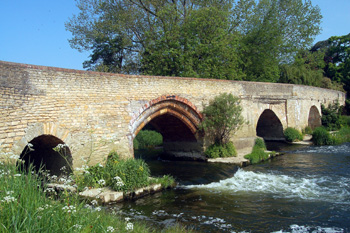
Harrold Bridge in May 2008
In the foreground is a good reach, right and left, of the winding bed of the river, and beyond it, on the left, among trees, are seen many of the houses of Harrold, the mill which juts out into the river above the church, the church spire, and Harrold Hall the grounds of which are divided from the churchyard by the sacred building itself. In front and on the right are the bridge, which is said to be very old, and the valley of the river passing round behind the hill on which stands the conspicuous church of Chellington. The causeway, from which this view is seen, is a very useful structure: last week the main road running by its side held at least a foot of water on it. Of whatever age the bridge may be, I should judge that the causeway itself is very old. Mere masonry is a deceptive indication of age but I found on the causeway several plants which usually establish themselves on old walls and sandy places, and which I failed to detect anywhere else in the in the neighbourhood of Harrold. The yellow stonecrop may have been planted there but I should scarcely think it has been; however no one would have planted the little Echium or the viper's bugloss, which I take to be the survival of a flora that has disappeared from other spots in the immediate neighbourhood. Between the causeway and Chellington where the footway is continued through the field at a higher level than the road, the dividing hedge consists mainly of the barberry, which is sufficiently uncommon to deserve to thrive. Another point of view is worth reaching if the visitor would see Harrold and its surroundings to advantage. I mean the hilltop beyond the chalet-type homestead at the western end of the village. Here, sitting on a roadside gate and looking across a refreshingly good piece of barley, and enjoying the agreeable but unseasonable perfume of beans from a piece of ground behind me, I rested for some time, gazing upon the quiet landscape. The village roofs were hidden, but the river and the church and a couple of churches beyond the river all belonged to the picture that was marred only by the untimely overflow of the Ouse into the meadows.
From this spot we will return to the village, noting as we saunter along the beautiful lilac tint of the filaments on the long-stalked plantain that just now covers the grassy borders of the road and remarking also that the little cascade on the right, a dozen feet beneath the bank, is watering the first specimen we have seen this year, nearly in blossom, of the large hemp-agrimony. We find little to note in the streets. Wanting in the front flower-gardens of a village. harrold is also wanting in the continuous shop-fronts of a town. Like most small places of this character it is an unsatisfactory compromise between town and village.

Harrold United Reformed Church, June 2008
A tolerably large chapel bearing the date 1863 as that of its enlargement occupies, with a good schoolroom, a neatly fenced enclosure. I had to make several enquiries before I could discover anything more about the building than that it was "Mr. Goff's". Sectarian distinctions do not appear to be very clear to at least some of the people of Harrold but I eventually discovered that the chapel was an Independent one; and that a small new building near the market-place was a Mission-Hall where Mr. Croxford held a service every Sunday evening, and where meetings of different kinds were frequently held on other evenings.
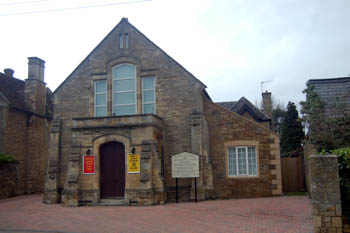
Grace Baptist Church, January 2008
The National School of which Mr. H. Marchant is master, and Mrs. Marchant, mistress, stands opposite the Market-place, and bears date 1847. Considering that at this date the modern educational movement was only in its early stages, the school building at Harrold is very creditable one. It has been recently supplemented by the erection of an infant school.
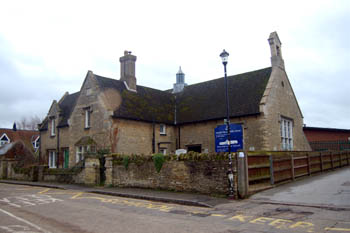
The former Harrold National School, January 2008
In front of the school is the market-place where stands a small open octagonal edifice, with a lantern above the point of the roof, and the whole supported by eight wooden pillars resting upon the same number of short stone posts. There does not appear to be anything to keep the building in its place but its weight: and i am inclined to think that a gale, such as I have often witnessed on the coast, would dislodge it. But perhaps it never knows "great guns" here in the middle of England, or the spot may be sheltered by houses and the healthy young lime trees which are growing up around it.

The Market House, May 2008
A little beyond the market-place, and nearer the river, stands a Roundhouse, with a conical stone roof. These old village prisons are passing not only out of use - as is the case at Harrold, the prisoners being now lodged at Sharnbrook - but also out of existence. The Harrold specimen is in nobody's way, and looks strong enough to last very many years. The authorities should take care of it, as a curiosity
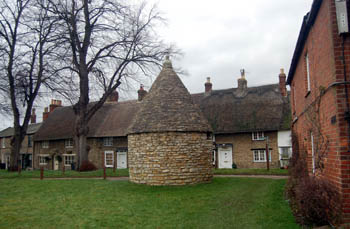
Harrold Lock-up, January 2008
From the Roundhouse, a footpath leads into a pasture through which is a wide gravelled way to the church. Some of the finest walnut trees I have ever seen stand in this pasture. About fifty yards from the path is the river, and the bank is a very pleasant spot. If Harrold were to ever feel the need of a little public promenade or pleasure ground, this part of the pasture should be selected for that purpose. An embankment and a garden between the river and the present public path would surely not be too costly for the people of Harrold. A few entertainments during the year, a few donations at first, and perhaps a little help in kind or in labour, would give the town an exceedingly pleasant lounge and promenade for either winter or summer. I might mention that in order to appreciate the spot I committed a trespass. A board is raised high on a post close by the river: but that it threatened trespassers with prosecution I had no means of knowing until I had committed the trespass, for it was impossible to read the words from the path, fifty yards away.
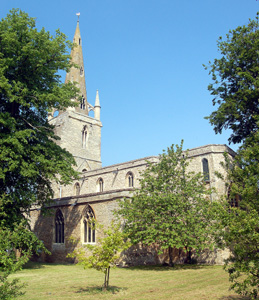
Harrold church from the south-east, May 2008
We now come to the church, which, as I have already said, forms the boundary between the grounds of Harrold Hall and the graveyard. The Hall is at present tenantless. There appears to be some doubt whether the church is dedicated to St. Peter or All Saints; but at all events, even if the latter be the dedication, St. Peter is included among the saints. A fine tower, in the Decorated style is surmounted by a high octagonal spire, connected at its base with four pinnacles of the tower by flying buttresses, which form arches over the narrow passage running round he spire without a parapet. Five bells occupy the highest part of the tower. I had no time to decipher their inscriptions: but the one nearest to the little door by which the bell-loft is entered has the date 1613, with the last figure reversed. It would be tedious to general readers to describe in detail all the peculiarities of the architecture of the church, in which several styles are irregularly mixed up, not to the exclusion of what may be called the Churchwarden's Style, seen here in the hall-windows which have been patched into the east walls of the chancel and of the south aisle. The roof of the nave is nearly flat: but the weather moulding of a higher roof is to be seen on the tower.
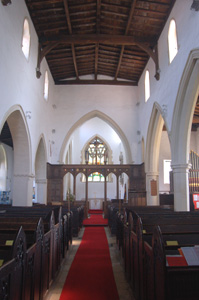
Harrold church interior looking east, May 2008
On the eastern wall of the chancel, over the table, are some cared wooden tablets containing the Commandments, &c., and which were the gift of the Rev. M. J. Taylor, a vicar who left Harrold in 1845. On the south side of the altar place is the altar tomb of Oliver Boteler, of Wootton Bourne End, who died in 1857. On the same south wall, Dame Alice Jolliffe, who died in 1732, is commemorated by a handsome monument with a bust. On the north side of the chancel is a chapel, forming practically a continuation of the north aisle. here is a very good organ, built about ten years ago. In the wall is a double locker. On the east wall are a large Decorated niche and a bracket by the side of it. Near the tower in the nave stands an old font, round topped with a pedestal of four shafts connected by projecting angles of stone.
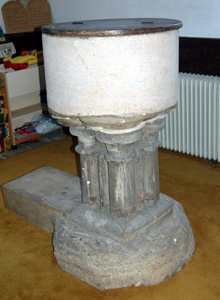
Harrold church - font May 2008
An old screen of four small and one larger panels stretches across the archway by which the nave opens into the chancel and harmonises well with the carved oaken reading desk and pulpit that occupy the angles at the east end of the nave.
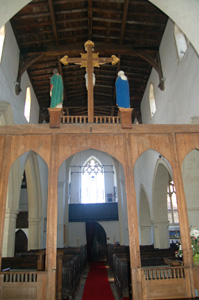
Harrold church - interior looking west May 2008
Some of the pews on either side of the screen are evidently very old, and are high enough to hide their occupants from observation. One of my visits to Harrold was on the Feast Sunday, when I attended the afternoon service. I was put into the pew beneath the pulpit. During the reading of the prayers and the lessons, I could not tell from the evidence of my eyes that any one was in the church besides the clergyman and myself; and during the sermon I could not see even the preacher, and thus had no evidence of the presence of anyone but myself and a voice. When the service was over, a number of loaves were given away, as is done every Sunday, in accordancewith the requirements of a bequest, to sixteen of the oldest widows in the town, or failing so many widows, to other poor and deserving persons. Among the curiosities of the church is an old stone coffin, which was dug up in the garden of the hall and now stands in the basement of the tower.

A medieval grave slab in Harrold church porch May 2008
Passing from the church through the small and well-filled graveyard, my attention was arrested by the frequency of the name of Fairey on the gravestones fringing the pathway. I counted no less than thirteen stones bearing that name, and five others with the name of Stevens, a family - I was told - related to that of the Faireys.
Concerning the industrial life of the people of Harrold, I learnt that lace making is a considerable trade in the place, and that shoemaking occupies a few hands. Leather-dressing also is carried on there to a considerable extent. The intellectual development on the inhabitants appears to be left to the school and places of worship - there is no reading room in the place, though there are frequent meetings, more or less distinctly religious,or connected in some way with the temperance movement. But is it not possible to organise and maintain a reading-room committee with a news-table and a library? Both the Odd Fellows and the Foresters have representatives at Harrold: and there are also two purely local friendly societies - the Wheatsheaf Club, founded in 1810, but which now meets at the Globe, and one which I was told was called the Tradesmen's Club.
To strangers living in constant intercourse with the world of business or of letters, or of both, life at a place like Harrold does not seem very attractive, except in moments of reaction after too great activity. There is neither the complete rusticity of a village, nor teh social organisation of a town. But of course a stranger sees such a place without looking at it through a mental atmosphere of interesting personal associations. I can quite appreciate the feeling of a fellow-traveller who was talking to me a few days ago about this very place. "Harrold," he said "is not much of a place, but I was born there, and I feel towards it very much as the Jews did towards Jerusalem".